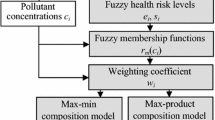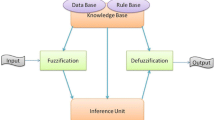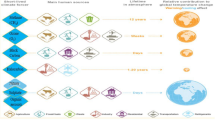Abstract
Environmental exposure assessments (EEA) and epidemiological studies require urban air pollution models with appropriate spatial and temporal resolutions. Uncertain available data and inflexible models can limit air pollution modeling techniques, particularly in under developing countries. This paper develops a hierarchical fuzzy inference system (HFIS) to model air pollution under different land use, transportation, and meteorological conditions. To improve performance, the system treats the issue as a large-scale and high-dimensional problem and develops the proposed model using a three-step approach. In the first step, a geospatial information system (GIS) and probabilistic methods are used to preprocess the data. In the second step, a hierarchical structure is generated based on the problem. In the third step, the accuracy and complexity of the model are simultaneously optimized with a multiple objective particle swarm optimization (MOPSO) algorithm. We examine the capabilities of the proposed model for predicting daily and annual mean PM2.5 and NO2 and compare the accuracy of the results with representative models from existing literature. The benefits provided by the model features, including probabilistic preprocessing, multi-objective optimization, and hierarchical structure, are precisely evaluated by comparing five different consecutive models in terms of accuracy and complexity criteria. Fivefold cross validation is used to assess the performance of the generated models. The respective average RMSEs and coefficients of determination (R 2) for the test datasets using proposed model are as follows: daily PM2.5 = (8.13, 0.78), annual mean PM2.5 = (4.96, 0.80), daily NO2 = (5.63, 0.79), and annual mean NO2 = (2.89, 0.83). The obtained results demonstrate that the developed hierarchical fuzzy inference system can be utilized for modeling air pollution in EEA and epidemiological studies.











Similar content being viewed by others
References
Aguilera I et al. (2015) Land use regression models for crustal and traffic-related PM2.5 constituents in four areas of the SAPALDIA study. Environ Res 140:377–384
Akaike H (1974) A new look at the statistical model identification. IEEE Trans Autom Control 19:716–723
Alcalá R, Alcalá-Fdez J, Herrera F (2007a) A proposal for the genetic lateral tuning of linguistic fuzzy systems and its interaction with rule selection. IEEE Trans Fuzzy Syst 15:616–635
Alcalá R, Gacto MJ, Herrera F (2011) A fast and scalable multiobjective genetic fuzzy system for linguistic fuzzy modeling in high-dimensional regression problems. IEEE Trans Fuzzy Syst 19:666–681
Alcalá R, Gacto MJ, Herrera F, Alcalá-Fdez J (2007b) A multi-objective genetic algorithm for tuning and rule selection to obtain accurate and compact linguistic fuzzy rule-based systems. Int J Uncertain Fuzz Knowledge-Based Syst 15:539–557
Arfaeinia H, Kermani M, Aghaei M, Bahrami Asl F, Karimzadeh S (2014) Comparative investigation of health quality of air in Tehran, Isfahan and Shiraz metropolises in 2011-2012. J Health Field 1:37–44 In Persian
Arunraj N, Mandal S, Maiti J (2013) Modeling uncertainty in risk assessment: an integrated approach with fuzzy set theory and Monte Carlo simulation. Accid Anal Prev 55:242–255
Benítez AD, Casillas J (2013) Multi-objective genetic learning of serial hierarchical fuzzy systems for large-scale problems. Soft Comput 17:165–194
Briggs DJ, Sabel CE, Lee K (2008) Uncertainty in epidemiology and health risk and impact assessment. Environ Geochem Health 31:189–203
Camastra F et al. (2014) TERA: a tool for the environmental risk assessment of genetically modified plants. Ecol Inform 24:186–193
Camastra F et al. (2015) A fuzzy decision system for genetically modified plant environmental risk assessment using Mamdani inference. Expert Syst Appl 42:1710–1716
Chart-asa C, Gibson JM (2015) Health impact assessment of traffic-related air pollution at the urban project scale: influence of variability and uncertainty. Sci Total Environ 506:409–421
Chen Y, Dong J, Yang B (2004) Automatic design of hierarchical TS-FS model using ant programming and PSO algorithm. In: Artificial Intelligence: Methodology, Systems, and Applications. Springer, pp 285–294
Coello CAC, Pulido GT, Lechuga MS (2004) Handling multiple objectives with particle swarm optimization. IEEE Trans Evol Comput 8:256–279
Cordón O, Herrera F, Zwir I (2002) Linguistic modeling by hierarchical systems of linguistic rules. Fuzzy Syst IEEE Trans 10:2–20
Cordón O, Herrera F, Zwir I (2003) A hierarchical knowledge-based environment for linguistic modeling: models and iterative methodology. Fuzzy Sets Syst 138:307–341
Dannenberg AL, Bhatia R, Cole BL, Heaton SK, Feldman JD, Rutt CD (2008) Use of health impact assessment in the US: 27 case studies, 1999–2007. Am J Prev Med 34:241–256
de Hoogh K et al. (2014) Comparing land use regression and dispersion modelling to assess residential exposure to ambient air pollution for epidemiological studies. Environ Int 73:382–392
Dockery DW et al. (1993) An association between air pollution and mortality in six US cities. N Engl J Med 329:1753–1759
EPA U (2001) Risk assessment guidance for superfund: volume3—process for conducting probabilistic risk assessment chapter l, part A. Washington, IX
Gacto MJ, Alcalá R, Herrera F (2011) Interpretability of linguistic fuzzy rule-based systems: an overview of interpretability measures. Inf Sci 181:4340–4360
Guyonnet D, Bourgine B, Dubois D, Fargier H, Côme B, Chilès J-P (2003) Hybrid approach for addressing uncertainty in risk assessments. J Environ Eng 129:68–78
Helton JC, Davis FJ (2003) Latin hypercube sampling and the propagation of uncertainty in analyses of complex systems. Reliab Eng Syst Saf 81:23–69
Herrera F (2008) Genetic fuzzy systems: taxonomy, current research trends and prospects. Evol Intel 1:27–46
Herrera F, Martínez L (2000) A 2-tuple fuzzy linguistic representation model for computing with words. IEEE Trans Fuzzy Syst 8:746–752
Hoek G, Beelen R, de Hoogh K, Vienneau D, Gulliver J, Fischer P, Briggs D (2008) A review of land-use regression models to assess spatial variation of outdoor air pollution. Atmos Environ 42:7561–7578
Hosseiniebalam F, Ghaffarpasand O (2015) The effects of emission sources and meteorological factors on sulphur dioxide concentration of great Isfahan, Iran. Atmos Environ 100:94–101
Iman RL, Davenport JM, Zeigler DK (1980) Latin hypercube sampling (program user’s guide).[LHC, in FORTRAN]. Sandia Labs., Albuquerque, NM (USA)
Ishibuchi H, Nozaki K, Yamamoto N, Tanaka H (1995) Selecting fuzzy if-then rules for classification problems using genetic algorithms. IEEE Trans Fuzzy Syst 3:260–270
Jamshidi A, Yazdani-Chamzini A, Yakhchali SH, Khaleghi S (2013) Developing a new fuzzy inference system for pipeline risk assessment. J Loss Prev Process Ind 26:197–208
Jelleli TM, Alimi AM (2010) Automatic design of a least complicated hierarchical fuzzy system. In: Fuzzy Systems (FUZZ), IEEE International Conference on, 2010. IEEE, pp 1–7
Jin Y (2000) Fuzzy modeling of high-dimensional systems: complexity reduction and interpretability improvement. Fuzzy Syst IEEE Trans 8:212–221
Kentel E, Aral M (2005) 2D Monte Carlo versus 2D fuzzy Monte Carlo health risk assessment. Stoch Env Res Risk A 19:86–96
Khoshnevisan B, Rafiee S, Omid M, Mousazadeh H, Clark S (2014) Environmental impact assessment of tomato and cucumber cultivation in greenhouses using life cycle assessment and adaptive neuro-fuzzy inference system. J Clean Prod 73:183–192
Lee M-L, Chung H-Y, Yu F-M (2003) Modeling of hierarchical fuzzy systems. Fuzzy Sets Syst 138:343–361
Leung W, Noble B, Gunn J, Jaeger JA (2015) A review of uncertainty research in impact assessment. Environ Impact Assess Rev 50:116–123
López V, Fernández A, Del Jesus MJ, Herrera F (2013) A hierarchical genetic fuzzy system based on genetic programming for addressing classification with highly imbalanced and borderline data-sets. Knowl-Based Syst 38:85–104
Lu H, Feng M, He L, Ren L (2015) Optimization-based multicriteria decision analysis for identification of desired petroleum-contaminated groundwater remediation strategies. Environ Sci Pollut Res 22:9505–9514
Malinowska A (2011) A fuzzy inference-based approach for building damage risk assessment on mining terrains. Eng Struct 33:163–170
Marchini A, Facchinetti T, Mistri M (2009) F-IND: a framework to design fuzzy indices of environmental conditions. Ecol Indic 9:485–496
Marshall JD, Nethery E, Brauer M (2008) Within-urban variability in ambient air pollution: comparison of estimation methods. Atmos Environ 42:1359–1369
Mesa-Frias M, Chalabi Z, Foss AM (2014) Quantifying uncertainty in health impact assessment: a case-study example on indoor housing ventilation. Environ Int 62:95–103
Mohammadi A, Rahimi S (2013) The impacts of landuse on spatial variation of air pollutant in Tehran (In Persian). Res Urban Plan 14:123–142
Mölter A, Lindley S, de Vocht F, Simpson A, Agius R (2010) Modelling air pollution for epidemiologic research—part I: a novel approach combining land use regression and air dispersion. Sci Total Environ 408:5862–5869
Morgan RK (2012) Environmental impact assessment: the state of the art. Impact Assess Project Appraisal 30:5–14
Ocampo-Duque W, Osorio C, Piamba C, Schuhmacher M, Domingo JL (2013) Water quality analysis in rivers with non-parametric probability distributions and fuzzy inference systems: application to the Cauca River, Colombia. Environ Int 52:17–28
Prüss-Üstün A, Corvalán C (2006) Preventing disease through healthy environments. World Health Organization, Geneva
Raju G, Zhou J, Kisner RA (1991) Hierarchical fuzzy control. Int J Control 54:1201–1216
Ratnayake RC (2014) Application of a fuzzy inference system for functional failure risk rank estimation: RBM of rotating equipment and instrumentation. J Loss Prev Process Ind 29:216–224
Rowangould GM (2015) A new approach for evaluating regional exposure to particulate matter emissions from motor vehicles. Transp Res Part D: Transp Environ 34:307–317
Schram-Bijkerk D, van Kempen E, Knol A, Kruize H, Staatsen B, van Kamp I (2009) Quantitative health impact assessment of transport policies: two simulations related to speed limit reduction and traffic re-allocation in the Netherlands. Occup Environ Med 66:691–698
Singleton-Baldrey L (2012) The impacts of health impact assessment: a review of 54 health impact assessments, 2007–2012. University of North Carolina at Chapel Hill, Chapel Hill
Stoeglehner G (2010) Enhancing SEA effectiveness: lessons learnt from Austrian experiences in spatial planning. Impact Assess Project Appraisal 28:217–231
Tainio M, Tuomisto JT, Hänninen O, Ruuskanen J, MJ J, Pekkanen J (2007) Parameter and model uncertainty in a life-table model for fine particles (PM2.5): a statistical modeling study. Environ Health 6:24
Tenailleau QM, Mauny F, Joly D, François S, Bernard N (2015) Air pollution in moderately polluted urban areas: how does the definition of “neighborhood” impact exposure assessment? Environ Pollut 206:437–448
USEPA (2001) Risk assessment guidance for superfund: volume III. Part A: process for conducting probabilistic risk assessment. Environmental Protection Agency; Office of Emergency and Remedial Response Washington^ eDC DC,
Venkatramanan S, Chung S, Rajesh R, Lee S, Ramkumar T, Prasanna M (2015) Comprehensive studies of hydrogeochemical processes and quality status of groundwater with tools of cluster, grouping analysis, and fuzzy set method using GIS platform: a case study of Dalcheon in Ulsan City, Korea. Environ Sci Pollut Res 22:11209–11223
Vlachokostas C et al. (2009) Decision support system for the evaluation of urban air pollution control options: application for particulate pollution in Thessaloniki, Greece. Sci Total Environ 407:5937–5948
Walker WE, Harremoës P, Rotmans J, van der Sluijs JP, van Asselt MB, Janssen P, Krayer von Krauss MP (2003) Defining uncertainty: a conceptual basis for uncertainty management in model-based decision support. Integr Assess 4:5–17
Wang L-X, Mendel JM (1992) Generating fuzzy rules by learning from examples. IEEE Trans Syst Man Cybern 22:1414–1427
White L, Noble BF (2013) Strategic environmental assessment for sustainability: a review of a decade of academic research. Environ Impact Assess Rev 42:60–66
WHO (2013) Review of evidence on health aspects of air pollution—REVIHAAP project: final technical report. The WHO European Centre for Environment and Health, Bonn
Zajaczkowski J, Verma B (2012) Selection and impact of different topologies in multi-layered hierarchical fuzzy systems. Appl Intell 36:564–584
Zarrabi A, Mohammadi J, Abdollahi A (2010) Evaluation of mobile and stationary sources of Isfahan air pollution. Geography 26:151–164 (In Persian)
Zhang X, Onieva E, Perallos A, Osaba E, Lee VC (2014) Hierarchical fuzzy rule-based system optimized with genetic algorithms for short term traffic congestion prediction. Trans Res C Emerg Technol 43:127–142
Zonouz SA, Miremadi SG (2006) A fuzzy-Monte Carlo simulation approach for fault tree analysis. In: Reliability and Maintainability Symposium. RAMS'06. Annual, 2006. IEEE, pp 428–433
Author information
Authors and Affiliations
Corresponding author
Additional information
Responsible editor: Gerhard Lammel
Rights and permissions
About this article
Cite this article
Tashayo, B., Alimohammadi, A. Modeling urban air pollution with optimized hierarchical fuzzy inference system. Environ Sci Pollut Res 23, 19417–19431 (2016). https://doi.org/10.1007/s11356-016-7059-5
Received:
Accepted:
Published:
Issue Date:
DOI: https://doi.org/10.1007/s11356-016-7059-5




